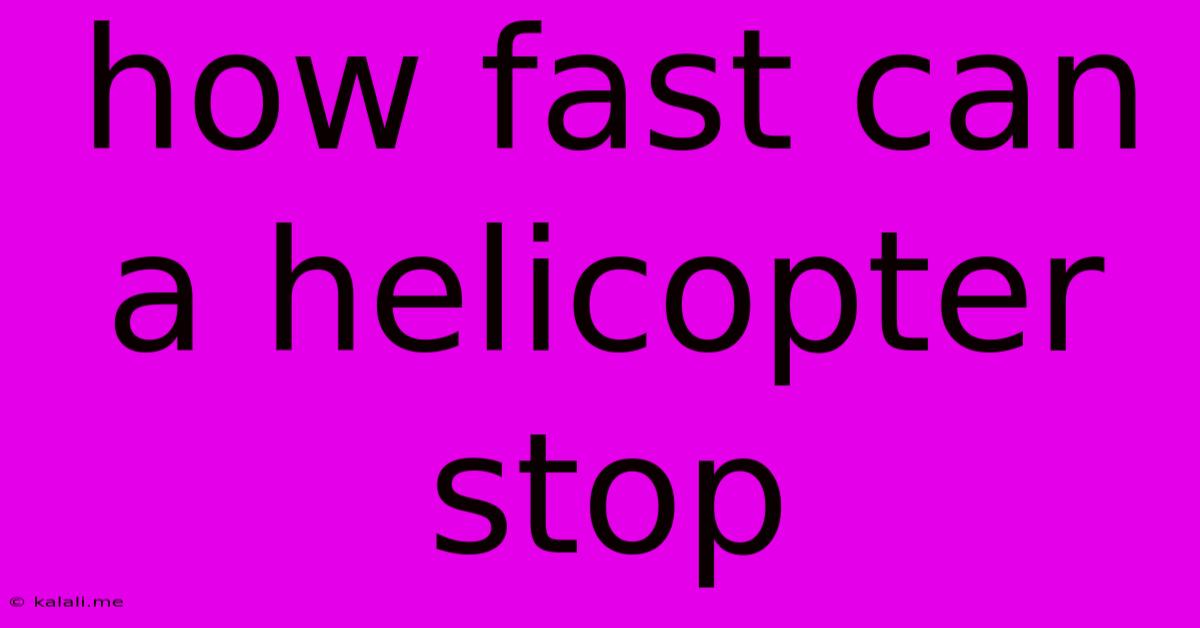How Fast Can A Helicopter Stop
Kalali
May 25, 2025 · 3 min read

Table of Contents
How Fast Can a Helicopter Stop? It's Not as Simple as You Think
Helicopters, symbols of vertical flight and maneuverability, often conjure images of swift ascents and graceful descents. But how quickly can these impressive machines actually stop? The answer, unfortunately, isn't a simple number. Stopping a helicopter is a complex process influenced by several factors, making a definitive "speed" impossible to state. This article will delve into the mechanics and variables that dictate a helicopter's stopping time.
Understanding the Dynamics of Helicopter Stopping
Unlike airplanes that rely on aerodynamic drag for deceleration during landings, helicopters use a more nuanced approach. Their stopping ability depends heavily on the pilot's skill, the helicopter's design, and the prevailing environmental conditions. Let's explore the key elements:
The Role of the Rotor System
The main rotor system is paramount in slowing and stopping a helicopter. By adjusting the collective pitch (the angle of the rotor blades), the pilot controls the helicopter's lift. Reducing the collective pitch decreases lift, causing the helicopter to descend. Simultaneously, controlling the cyclic pitch (the angle of the rotor disc) allows for precise directional control during the descent. A skilled pilot can finely manage these controls to achieve a smooth and controlled stop.
Environmental Factors: Wind and Terrain
External factors significantly influence stopping time. Strong headwinds can increase the distance needed to decelerate, while tailwinds may shorten it. Similarly, the terrain plays a crucial role. A flat, open area provides ample space for a controlled descent, whereas mountainous or densely populated regions necessitate a more cautious approach, potentially extending the stopping time significantly.
Helicopter Type and Size
Different helicopters possess varying stopping capabilities. Larger, heavier helicopters require more time and distance to stop compared to their smaller, lighter counterparts. The design of the rotor system, engine power, and overall weight all contribute to the braking performance. A military helicopter, for instance, might have a different stopping profile compared to a civilian model.
The Pilot's Expertise
The pilot's experience and skill are perhaps the most influential factor. A highly trained pilot can execute precise maneuvers to achieve a quicker and safer stop, especially in challenging conditions. Their ability to anticipate wind shifts, adjust to changing altitudes, and maintain stable control throughout the stopping process is critical.
Measuring "Stopping Time" – A Multifaceted Concept
Instead of focusing on a single "stopping speed," it's more accurate to consider the various phases of a helicopter's deceleration:
- Initial Descent: The rate at which the helicopter begins its descent from cruising altitude. This is controlled primarily by the pilot's manipulation of the collective pitch.
- Approach to Landing: The gradual reduction in vertical and horizontal speed as the helicopter approaches the ground. This phase requires precise adjustments to maintain stability and control.
- Final Flare and Touchdown: The final few feet before landing where the pilot subtly adjusts the controls to achieve a gentle touchdown. This phase is especially crucial for preventing a hard landing.
Each phase contributes to the overall stopping time, making a single numerical value misleading.
In Conclusion
There isn't a simple answer to how fast a helicopter can stop. The process is a complex interplay of pilot skill, aircraft design, environmental conditions, and the phases of deceleration. Rather than a single speed, it's more appropriate to appreciate the intricate control and expertise required for a safe and efficient landing. Understanding these factors provides a more comprehensive appreciation for the sophisticated engineering and piloting skills involved in helicopter operation.
Latest Posts
Latest Posts
-
How To Flush Metal Contaminants From An Engine
May 25, 2025
-
How Long Can Tuna Salad Stay In The Fridge
May 25, 2025
-
Can You Check Into A Hotel Early
May 25, 2025
-
How Long Is Cookie Dough Good In The Fridge
May 25, 2025
-
How Long To Smoke A 20lb Turkey
May 25, 2025
Related Post
Thank you for visiting our website which covers about How Fast Can A Helicopter Stop . We hope the information provided has been useful to you. Feel free to contact us if you have any questions or need further assistance. See you next time and don't miss to bookmark.